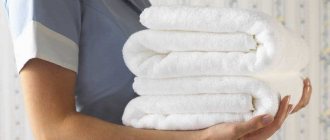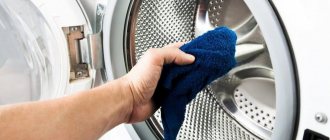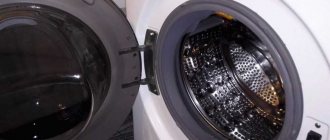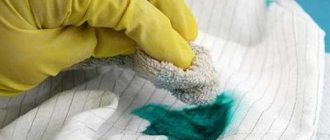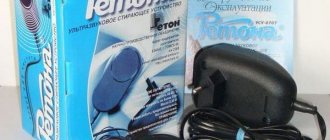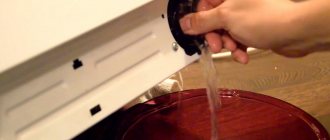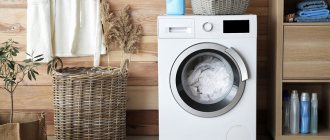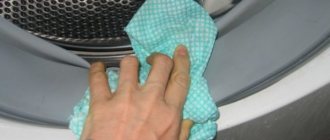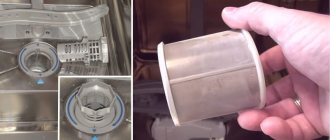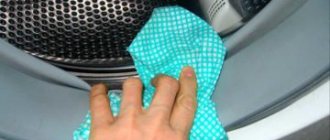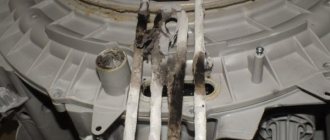Mold in a washing machine not only affects the appearance and condition of the equipment, but also has a harmful effect on human health. If you notice black spots on the rubber seal or smell dampness and mustiness from the drum, this means that fungus has appeared there. We urgently need to take action. How to quickly get rid of mold in a washing machine, read our article.
Most often, mold occurs due to improper use and poor care of equipment.
Ways to get rid of mold in a washing machine
If the case is not advanced, you can relatively quickly and easily remove mold from the surfaces of the machine with your own hands and using a rag. But most often we see a problem because it is too big. If mold has developed in hidden cavities of the tank and hard-to-reach units, you need to take the matter seriously and thoroughly.
Heat and acid
Mold does not tolerate high temperatures and acids. A dry environment is also uncomfortable for her.
- Turn on the washing machine for a long wash at 95 degrees (without putting laundry in it). Pour about a liter of chlorine bleach, such as Blezna, into the dispenser tray.
- When the temperature reaches its maximum, pause the wash cycle for a few hours.
- Turn on the machine again and wait until the wash is completed.
- Pour 3 cups of 11% table vinegar into the dispenser tray. Turn on the machine in rinse mode.
- After the process is completed, open the machine and dry it thoroughly. You can even wipe with a dry towel to speed up drying.
Some housewives prefer to use vinegar and bleach at the same time. But this method is too radical and can harm machine parts.
Baking soda, citric acid and laundry detergent with bleach will help you deal with mold.
sunlight
If possible, take the washing machine outside in sunny, hot weather. Ultraviolet light is harmful to black mold. Leave the machine with the lid open in the sun for one day and the fungal colonies will be destroyed.
Copper sulfate
Rub the inside of the rubber cuff with a 50% solution of copper sulfate. Leave for a day, then wash with water and powder or detergent. If you do this after every wash, mold will no longer appear.
Lemon acid
A solution of citric acid will help not only remove mold, but also eliminate unpleasant odors. Dilute citric acid (400 g) in a liter of water, pour the solution into the powder tray and turn on the machine for the maximum washing time. Select the “boiling” mode without adding laundry.
Ventilation
Often mold forms inside the cuff because the machine is poorly ventilated. Therefore, after each wash, be sure to leave the door open to prevent moisture from getting a chance.
Use of special equipment
If none of the above methods help, then you will have to disassemble the machine and thoroughly wash all internal surfaces. To do this, you can use soda, Domestos or special products that destroy fungus. After this, keep the cleaned parts in the sun or under an ultraviolet lamp.
Method 1: Cleaning powder
If the problem is at the initial stage, then a product such as cleaning powder will help get rid of the unpleasant odor and black spots. You can use a brush or sponge - they are equally easy to clean the affected areas.
To prevent re-growth of spores, the treated elements should be additionally coated with a special anti-fungal solution.
What to do if mold appears on the rubber band of your washing machine
The main reason why your washing machine smells musty is because there is fungus in it. It must be dealt with, since a person may experience various allergic reactions. As a result, the immune system is weakened, and many other infections can attack the body.
In order to remove mold from the rubber band of a washing machine as much as possible, you need to understand what it is most afraid of. It is necessary to act in several ways at once, then the result will be. The fungus disappears if it is exposed to acids and high temperatures. Also, all parts of the washing machine must be dry.
In this case, you need to do the following:
- pour “Belizna” into the powder dispenser;
- start the long-term wash mode at maximum temperature;
- After an hour of washing, you need to stop the program and let the machine stand for about an hour. After this, continue washing;
- after the main program ends, pour a few tablespoons of vinegar into the measuring tank, and then turn on the “Rinse” mode;
- after rinsing, you must thoroughly wipe all the internal parts of the machine;
- also wipe the measuring tanks dry;
- The washing machine should be left open for several days to allow the unpleasant odor to dissipate.
How to clean the tray in the machine
If the car smells damp, but the fungus is not visible externally, this is not a reason to think that it is not there. Colonies can hide under a rubber rim or in other secret places (in a hose, drain). You can get rid of smell and mold in an automatic washing machine at home using different methods.
This is a more concentrated acid, so you will need less of it: half a glass. The washing is started in the same mode. Only the vinegar is not poured in immediately, but after the machine has drained the first portion of water.
Other remedies that can eliminate the immediate problem are baking soda, dishwasher tablets, and chlorine bleach.
For treatment, mix several tablespoons of soda with water to obtain a paste-like mass, which is used to treat fungal lesions with a brush. The baking soda should work for about half an hour. After this, they also start the wash “idle”, setting the maximum time and temperature. For greater effectiveness, you can pour a couple of spoons of powder into the tray.
Cleaning with dishwasher tablets
The peculiarity of this method is that the tablets (6 pieces) are placed not in a powder reservoir, but directly in a drum. Next, start the wash as described above. Approximately in the middle of the cycle, you need to pause the program (or turn off the machine if it does not have such a function) and wait for at least 3 hours. During this time, boiling water and the active ingredients of the tablet should remove odor and mold. After this, the washing is completed.
Cleaning with chlorine-containing products
This method of eliminating odor and fungus is good for very advanced cases, but is not suitable for all cars. The instructions must indicate that the use of chlorine is acceptable.
The principle is the same: long wash at high temperature without laundry. Pour a liter of chlorine bleach into the powder reservoir and start the wash. Likewise, in the middle of the process, the machine is stopped for at least an hour and a half, after which it is started again.
At the end of the cycle, pour 2 cups of 9% vinegar into the tank and start the rinse mode.
When cleaning at home, pay attention to the sounds your washing machine makes. If large pieces of plaque and scale get into the drain, they must be removed immediately, otherwise your assistant may be damaged. Unusual noise, whistling, grinding, buzzing is a reason to immediately press pause and check for the presence of pieces of deposits in the drum and drain.
Cleaning the powder receiver compartment was not easy, as there were a lot of hard-to-reach places, small protruding parts and grooves covered with rust. We deliberately did not bring the result to the ideal; it was too labor-intensive work.
You can do something more cunning: generously spray all the walls of the compartment with a cleaning agent from a spray bottle, leave the plaque to soak for a couple of hours, and only then start cleaning by hand.
Next, we proceed to cleaning the tray itself, which is usually covered with a rusty coating, remnants of powder and other cleaning additives. For this you can use:
- A mixture of vinegar and soda;
- Pemolux and other household chemicals;
- A mixture of hot water, vinegar and soda.
Cover the container with your chosen product and leave/soak it for 30 minutes, or preferably a couple of hours.
If you have a dishwasher, you can wash the tray in it. The rust may not completely disappear, but cleaning it in the dishwasher will make it much easier to remove.
Well, that's all, the inside of the car is clean and ready for work! All you have to do is restore its external beauty: wipe the control panel (especially the protruding buttons), wash the door inside and out, wipe the top and side panels.
How to Prevent Mold Formation
To ensure that future use of the washing machine does not lead to the appearance of fungus, you need to use it correctly. For prevention, every month add citric acid to the powder compartment and run a long wash cycle without putting laundry in the drum. This procedure will get rid of mold and scale and protect against bacteria.
Often, fungus spreads in the washing machine due to rinse aids. Moreover, the higher the cost of the product, the better mold spreads in its remains. Therefore, after each use of the conditioner, remove the tray and rinse it well, and wipe the inside of the drum with a cloth.
Do not store dirty laundry in the washing machine; the appliance is not designed for this. In addition, sweat, epithelial particles and fat are an excellent environment for the spread of mold and the appearance of an unpleasant odor. Therefore, dirty clothes must be placed in a special basket.
When to seek the help of a professional
In addition to using home remedies, you can clean your washing machine with special household chemicals in the form of solutions and sprays. The composition of such preparations includes several types of acids. They have special marks “for disinfection” or “from mold”. They are used strictly according to the instructions and applied to moldy stains for the time recommended for basic cleaning.
If, despite all your efforts, you cannot get rid of the mold and the unpleasant odor reappears, you will have to call washing machine repair specialists for help. After disassembling the unit, the technician will clean all parts. Some of them may need to be changed.
Where does mold appear?
The growth of fungus on rubber components of automatic machines is usually caused by the following factors:
- Humidity. The household appliance is mainly installed in the bathroom. Regular high air humidity is the main cause of mold. To minimize the development of fungus from inside the drum, you should always open the machine door for ventilation after washing.
- Warm. Black plaque forms faster in warm rooms. In addition, its appearance is stimulated by warm water used for washing.
- Dirt. Bacteria and spores constantly get into the drum of the machine from things. This is a favorable environment for mold development and odor.
If the drum begins to smell unpleasant, and black spots appear in some places, you need to take immediate action. However, before destroying the fungus, it must be found. Sometimes this task causes some difficulties. Mold mainly develops in:
- filter;
- compartment for powder and conditioner;
- on elastic bands inside the drum;
- on the inlet and drain hoses.
The appearance of black mold inside a household appliance should not be ignored. These microspores lead to the development of local and general allergic reactions. In particular, they cause itching, redness of the skin, and peeling. In severe cases, mold can cause Quincke's edema or severe urticaria. In addition, the fungus negatively affects the respiratory system. Regular penetration of spores into the respiratory tract leads to bronchitis, pneumonia, exacerbation or development of bronchial asthma.
The largest amount of fungus accumulates between the rubber bands that separate the porthole from the drum. Small debris often remains here, and the water takes a long time to evaporate. You can clean your washing machine from mold and dirt using folk recipes or using household chemicals.
Facilities
Table 1. How to remove mold from a washing machine.
| Name of the product | More details |
| Folk recipes | |
| Lemon acid | It is recommended to mix citric acid with washing powder in a ratio of 1:2. Dilute the resulting mixture with water to a paste-like state and apply to the affected areas. After 24 hours, rinse off the product with warm water. |
| Copper sulfate | Moisten a soft cloth generously with the liquid. Wipe the elements of the device with a cloth, then wash off with warm water and soap. |
| Household chemicals | |
| White | A quick way to get rid of fungus is to apply Whitening. Mold is “afraid” of chlorine in any form and lags behind literally before our eyes. For safety reasons, it is better to use gloves and a mask. |
Wipe the rubber seal thoroughly. This especially applies to the inside of the component. It needs to be cleaned with a soft cloth wrapped around your finger. Wash the machine door. You can use any detergent: soap, dishwashing gel, glass cleaner. Do the washing
To ensure mold removal, it is important to be sure to run the wash cycle at maximum temperature without pre-loading the laundry. For best results, you can add a little bleach to the water.
Cleaning products
Both traditional and special detergents from the hardware department of the store are used as a means to clean the washing machine from musty odors, mold and dirt. This process is easy and you can do it yourself. Let's look at popular cleansing products.
Copper sulfate
Copper sulfate can remove the mold itself for a long time, and also get rid of the mold smell in the washing machine. It consists of small blue particles. This powerful poison is used in agriculture when treating against bacteria, so gloves must be used for protection. To prepare the solution, mix copper sulfate, washing powder and water. Apply it to areas where mold accumulates and leave it there for several hours, then use a rinse cycle to remove any residue.
Hydrogen peroxide
A quick and easy way to remove mold is to replace chlorine bleach with 3% hydrogen peroxide. Both when used in medicine it is an antiseptic, and when used in equipment it combats several problems:
- Kills fungus.
- Removes limescale.
- Has an antibacterial effect.
- Destroys viruses.
Using hot water will help remove traces of mold more thoroughly. At the same time, it is safe and does not harm health.
Lemon acid
Citric acid is a commonly used remedy for getting rid of mold. For use, use a couple of packages of acid, which are sold in any market. Place it in the detergent compartment or in the drum, start the washing cycle at a temperature above 90 degrees, preferably with a soaking program. It is recommended to use this method every 4-5 months. Citric acid is great for removing musty smells from your car.
Bleaching
You can clean mold from your washing machine using chlorine bleach. Use it with warm or cold water, as it stops working in hot water. Limescale deposits do not disappear after bleaching and additional measures must be taken. Bleach may not get into the internal parts, so this method is good for light contamination. During cleansing, the product is left for several hours and an additional wash without powder is run at high temperature to remove residual chlorine-containing substances.
Soda
You can clean the washing machine from mold and get rid of the smell inside with soda. Soda is diluted with water to a paste and applied to areas where mold accumulates, leaving this mixture for half an hour. Next, rub the product over the surface with a sponge and start the rinsing mode. More effective cleaning will be when mixing the product with washing powder. Baking soda is good at getting rid of musty odors due to its ability to absorb bad odors.
Vinegar
Vinegar helps clean your washing machine, as does acetic acid. Only use a 9% solution of the product. It is recommended to use a synthetic substance. Apple cider vinegar or wine vinegar may contain oils that will only leave additional residue on the surface of the equipment. After cleaning, the unit must be wiped dry and ventilated well.
Chemicals
The following substances can be used:
- toilet fluid;
- washing powder;
- dishwashing liquid.
Toilet fluid perfectly kills fungus and various pathogens. Apply it to the inside of the machine, rubber surface, powder container. Leave for a few minutes and clean with a sponge. Wipe dry and run an express wash to remove excess substances.
External manifestations of black mold can be removed using the same washing powder and dishwashing detergent. This will not get rid of the fungus and it will begin to appear again. Therefore, other methods need to be used. The method of using cleansing is the same as for any cleaning. It is necessary to thoroughly wash all components of the equipment, then thoroughly rinse, wipe and ventilate the machine. The powder and dish soap are safe for skin and can be used without gloves.
Special products from hardware stores
Many people recommend cleaning your car with products from hardware stores. These products remove three problems at once: dirt, mold and scale.
They appear in the form of sprays, solutions or special powders. They are used both externally and added when washing to the detergent compartment. Cleaning in this way is very effective, but requires additional money. These products can be used for disinfection after washing very dirty items or for cleaning when washing children's clothes.
Prevention of relapse
Mold is a rather annoying and stubborn fungus. Once you delete it, you cannot be sure that it will not appear again. As soon as conditions are favorable, mold will settle in the washer again
To prevent this, it is important to constantly maintain an uncomfortable environment for her:
after each wash, be sure to wipe dry all accessible cavities: tray, drum, seal, elastic band, hatch; contrary to the annoying advertising video, it is important to leave the washing machine window slightly open between washes, but the tray must be removed, rinsed and left to dry; in the room where the machine is located, there must be a ventilation system, otherwise a problem may arise due to dampness not in the machine itself, but around it; after the end of the washing cycle, the laundry must be removed immediately, without allowing it to keep the drum wet; Do not store dirty things in the drum - there are special baskets or bins for this. Otherwise, a musty smell will appear in the machine (even if the laundry is dry, there are always microorganisms on it, and particles of dried food, dead skin cells, ingrained sweat or other secretions are an excellent environment for their reproduction); when using conditioner, it is better to pour in less of it than more, and be sure to run an additional rinse to wash away any remaining product; the rinse aid and powder must be of high quality; you cannot skimp on them for the benefit of fungal development; once a month it is necessary to treat the cavities of the machine with the hottest possible water using a “idle” wash at the maximum time and temperature - such prevention will allow you to regularly get rid of microorganisms and fungi, preventing them from multiplying; every six months it is advisable to “run” the washing machine without washing clothes with citric acid; the hose and filter also require cleaning at least once every six months
It is always easier to prevent any problem than to then look for ways to resolve it. Odor and mold in an automatic car is no exception. If you do not take preventive measures, in a favorable environment the fungus and the accompanying “aroma” will certainly appear, even if they were not there before. Well, if you have, you need to take extra care of your car.
- Use only as much powder, bleach and conditioner as you actually need (see product manufacturer's instructions). After all, excess detergents do not enhance the result, but simply settle and accumulate inside the washing machine.
- Always remove small items from pockets to prevent them from clogging the drain filter.
- Try not to delay starting the machine if you have already thrown dirty things into the drum. Well, take out clean clothes immediately after washing and send them to dry.
- Try to always keep the car open to prevent mold from growing in it due to high humidity.
How to clean an elastic band in a washing machine from mold and odor
The largest amount of fungus accumulates between the rubber bands that separate the porthole from the drum. Small debris often remains here, and the water takes a long time to evaporate. You can clean your washing machine from mold and dirt using folk recipes or using household chemicals.
Facilities
Cleaning the machine should be done regularly. Only in this case can the washed clothes really be considered clean.
| Name of the product | More details |
| Folk recipes | |
| Lemon acid | It is recommended to mix citric acid with washing powder in a ratio of 1:2. Dilute the resulting mixture with water to a paste-like state and apply to the affected areas. After 24 hours, rinse off the product with warm water. |
| Copper sulfate | Moisten a soft cloth generously with the liquid. Wipe the elements of the device with a cloth, then wash off with warm water and soap. |
| Household chemicals | |
| White | A quick way to get rid of fungus is to apply Whitening. Mold is “afraid” of chlorine in any form and lags behind literally before our eyes. For safety reasons, it is better to use gloves and a mask. |
Wipe the rubber seal thoroughly. This especially applies to the inside of the component. It needs to be cleaned with a soft cloth wrapped around your finger. Wash the machine door. You can use any detergent: soap, dishwashing gel, glass cleaner. Do the washing
To ensure mold removal, it is important to be sure to run the wash cycle at maximum temperature without pre-loading the laundry. For best results, you can add a little bleach to the water.
A musty smell may be due to the accumulation of fungus, powder, gel and conditioner residues in the washing machine tray. This phenomenon can be avoided by periodically soaking the element in warm water with the addition of chlorine. If blackheads have already appeared, then there are several ways to solve the problem.
Surely in your home “arsenal” you already have a couple of substances that can combat mold. How to get rid of mold in a washing machine:
- Using vinegar. This liquid copes well with spores. Vinegar should be poured directly into the powder compartment, and then run a full wash cycle. If the fungus is mild, then lightly wipe the surface of the tray.
- Hydrogen peroxide and baking soda. Using this combination will not only clean the tray of accumulated dirt, but will also whiten the plastic. This is an easy way to bring newness back to your home appliance. To carry out the procedure, grind 10 peroxide tablets and mix the powder with 200 g. baking soda. Pour the resulting composition into the powder compartment and carry out a long wash without items at maximum temperature with rinsing.
Instructions
There are ways to locally remove mold. For this:
- the tray must be removed and washed under running water;
- Apply citric acid, vinegar or chlorine to the plastic;
- Gently rub the substance in with a soft brush;
- thoroughly rinse the composition from the tray;
- Wipe the component dry and install it in place.
Cleaning the drum, powder tray and rubber bands is quite simple. It is much more difficult to deal with contaminants on the internal elements of the device.
Table 2. Methods for cleaning heating elements.
| Way | Information |
| Chemical means | You can remove scale and dirt by washing at high temperatures with the addition of vinegar, citric acid or special anti-scale agents. |
| Physical cleaning | Involves removing the heating element. It is better not to carry out the procedure yourself. After removal, clean the heating element by hand under running water. It is strictly forbidden to use sharp blades or sandpaper. |
| Residual cleaning | After manual processing, the removed heating element can be cleaned until shiny with lemon juice. The element is placed in a container with lemon juice, fruit slices or diluted citric acid and left for 10-12 hours until the scale has completely descaled. |
Fighting methods
You can get rid of mold in your washing machine using store-bought and homemade products. The former act faster and often more effectively (due to the content of aggressive chemical components). Some folk recipes cannot handle serious damage, but if the scale of the problem is small, start with homemade formulations.
Store-bought household chemicals
Every day the market is replenished with new offers with improved formulas
But can all manufacturers be trusted? In order not to spend large sums of money searching for “that” cleaner, pay attention to the rating of proven and popular products
Table 1. Ready-made chemicals
| Name | View | Manufacturer country | Mode of application | Volume, ml | price, rub. |
| "Domestos Universal" | Gel | USA | Apply to the drum, wipe the cuff with a sponge soaked in the product. Leave for 4 hours. Then turn on the rinse mode, followed by a wash at 90° adding citric acid to the tray | 1 000 | 120 |
| "White" | Liquid | Russia | Pour as much bleach as possible into the compartment (the entire bottle) and run a long wash cycle at high temperature. After 2 hours of work, pause (1.5 hours). Continue washing by adding a liter of vinegar to the rinse aid compartment. | 1 000 | 35 |
| "Deo-anti-mold" | Liquid concentrate | Russia | For 5 liters of water, 0.5–1 liter of concentrate is required (treat heavily affected surfaces without diluting). | 1 000 | 170 |
| Cillit Bang | Foam | Great Britain | Removes black mold in 15 minutes. Spray inside the drum, after a quarter of an hour, wipe with a washcloth, turn on the wash | 750 | 300 |
| Neomid | Antiseptic concentrate with water in a ratio of 1:20. | Russia | Antiseptic helps in advanced cases. Apply to problem areas, rinse after 40 minutes | 500 | 535 |
| Savo | Spray | Czech | Eliminates and prevents the appearance of fungus and mold. The active substance acts for 15–20 minutes, then it is washed off with water | 500 | 160 |
| Astonish Mold Mildew | Aerosol | England | The method of application is similar to the previous one | 750 | 270 |
Advice. Using any store-bought mold remover, after the procedure, wipe the tank with a dry cloth and leave the door open for 2 days so that the machine is well ventilated. Wear gloves when handling chemicals.
Home Recipes
On home economics forums you can find many stories about fighting fungus with folk remedies. But if you do not want to join the ranks of word of mouth participants, use ready-made, and most importantly, proven recipes.
Vinegar
Vinegar helps get rid of fungus in the machine by removing salt deposits. Do not use natural apple and grape compositions that may contain dyes and oils - marks will remain on the machine parts. The best option is 9% table vinegar.
Additionally, pour vinegar into the drum itself
Pour 150 ml into the powder compartment, select the maximum temperature and washing mode. When you start spinning, pause it. To eliminate mold, 30 minutes is enough, for limescale – 1.5 hours. After waiting the required time, unpause and complete the cycle. At the last stage, remove and clean the outlet filter, treat the seals, drum, and powder tray with a vinegar solution (50 ml of concentrate per 1,000 ml of water).
Soda
Soda is relevant in cases where minor manifestations of fungus are involved. Prepare a slurry by adding water, and treat the seal lip, drum surface, and cleaning agent bins with this mixture. As a tool, use a toothbrush (for hard-to-reach parts), thin brushes, and dish sponges.
Keep the composition for half an hour to an hour. Finish the process by adding washing powder (1 tbsp) to the tray and starting the machine. At the end of the wash, pull out and dry the outlet filter, wipe all surfaces dry, and ensure the drum is ventilated.
Lemon acid
A safe remedy in the form of a lemon helps remove mold from your car. The effect will be noticeable if the fungus has affected small areas. More often, acid is used as a preventative cleaning once every 3 months or to eliminate musty odors.
For best results, run the machine twice with lemon juice.
Pour 250 g of lemon into a dry powder container and turn on the longest washing program. In this case, there is no need to pause. After the end of the cycle, repeat all the usual steps of removing the filter, wiping parts, rubber, and drum. Do not close the hatch or door until the machine is completely dry.
Factory chemistry
Russian and foreign companies produce a huge number of products for cleaning mold from automatic washing machines. Various multi-component powders and gels are designed to directly dissolve mold in 1-2 applications and wash its remains from the tank, drum, pipes and hoses of the automatic washing machine. What means are we talking about?
- Kaneyo. This Japanese liquid product is equally good at ridding your washing machine of soap scum, mold, limescale and other dirt. Sold in 550 ml bottles. This amount of product is enough to clean the insides of a washing machine with a drum capacity of up to 9 kg. Price for 550 ml – 6.3 dollars.
- Nagara. Cleaning tablets from Japan that make it easy to clean your washing machine from mold and any other contaminants. The tablets are very effective and are relatively inexpensive - for 5 tablets you will pay 2 dollars.
- HG is a powdered product for automatically cleaning a washing machine from mold from Holland. Suitable for all types of machines. One pack of 0.162 l goes to a washing machine with a load of up to 7 kg. If your washing machine has a load of more than 7 kg, take two packs. One cleaning with HG248020161 will remove mold from the washing machine in all places where the solution reaches. The cost of the product is $10 per pack of 0.162 liters.
Nuances of using funds
If mold has grown in your washing machine, rest assured that it is growing not only in plain sight, but in the most inaccessible places. In this regard, it is preferable to use a mold cleaning powder or gel that will clean automatically.
This is very convenient; I poured or poured the product into the powder receptacle in the main wash compartment and ran an idle wash in hot water with a double rinse. At the end of the wash, the mold will come off. And you don’t need to crawl on your hands and knees in front of the machine, hoping to wipe off at least some of the mold with a rag—the automation will do everything. In this case, the main thing is to observe the dosage, since some products in excessive concentrations are dangerous for the parts of the washing machine. The following of the products we are considering are cleaned automatically:
- Kaneyo;
- Nagara;
- HG248020161;
- acetic acid.
Soda is suitable as a means for manually cleaning a washing machine from mold, but citric acid is suitable as a mixed product that can be used in any way. Cleaning the parts of a washing machine with lemon or soda is quite a labor-intensive task; you’ll wipe off all your fingers while you’re doing it. All you need is a pack of soda or lemon, a rag or sponge and your hands.
What should you not use?
On various information sites you can find recommendations on how to clean mold from a washing machine using bleach, various acids, and even Coca-Cola drink. These recommendations may well be considered untenable and even harmful. But let's sort it out in order.
- Whiteness is a very active concentrated chlorine-containing substance that will really quickly clean the washing machine of dirt, but it will also damage the rubber seals, which in turn will lead to leaks.
- Acids will cause the same damage as whiteness, but will additionally damage metal parts, for example, the drum will darken. There have been cases when users managed to burn through the drain pipe with acid, and this is absolutely “tough”.
- Coca-Cola has some cleaning properties due to the special chemicals it contains. True, to clean a washing machine with Coca-Cola, you will need about 20 liters of this drink, it’s quite expensive; it’s easier to buy several packs of lemon juice.
In conclusion, we note that agents against mold formed in a washing machine can be divided into two groups: special products and household chemicals adapted for cleaning. Household chemicals are cheaper, and in some cases more effective, the main thing is not to use substances that can harm the washing machine. Good luck!
Useful video
How to quickly and easily clean your washing machine:
The area around the door of a front-loading machine is an ideal breeding ground for germs. Accumulations of dirt, mucus, and foam residues settle on warm, damp rubber, where mold is successfully cultivated within a few days.
From dirt and stains
Black traces of fungus are a consequence of improper care of the washing machine. Gray plaque is easier to remove:
- Use a damp cotton cloth to remove dirt from accessible areas of the seal.
- Protect your hands with household gloves.
- Take out the inner surfaces of the elastic by bending the edges.
- Wash both sides of the cuff with a sponge soaked in Domestos.
- The door is left closed for 20–30 minutes.
- Turn on the drum cleaning mode.
- Wipe the seal dry and ventilate the drum until the next wash in the open state.
From plaque and rust
Rusty stains form along with black stains, growing intensively along the perimeter of the rubber band. Remove plaque with a solvent.
The best way is acetone nail polish remover:
- Ensure hand safety and pay attention to ventilation.
- Mechanically remove the layer of dirt with a napkin.
- The solvent is applied pointwise to the affected areas.
- Leave for an hour.
- Wash using rinse mode at a temperature not lower than 60 degrees.
From an unpleasant odor
The moldy aroma of rotten water will go away along with bacterial contamination.
When you only need to remove an unpleasant odor, use lemon:
- The zest is turned into thin shavings.
- The juice is squeezed out of the pulp.
- Strain from seeds and plant fibers.
- The shavings are placed in a laundry bag.
- Place inside the drum of the machine.
- Lemon juice is applied to the sealing gum, the insides of the drum, 2 tablespoons are poured into the tray.
- Start the rinse mode with a water temperature of 40 degrees.
- Wipe dry, ventilate.
From mold and mildew
Monarda extract will help clean the washing machine seal from germs. The product is sold in liquid form in pharmacy chains as a dietary supplement.
- A bottle of extract will last a long time. 15 ml are diluted in 200 ml of cool distilled water.
- Apply to the areas to be cleaned by spraying.
- No need to rinse off.
The disadvantage of the solution is a specific odor that quickly disappears.
